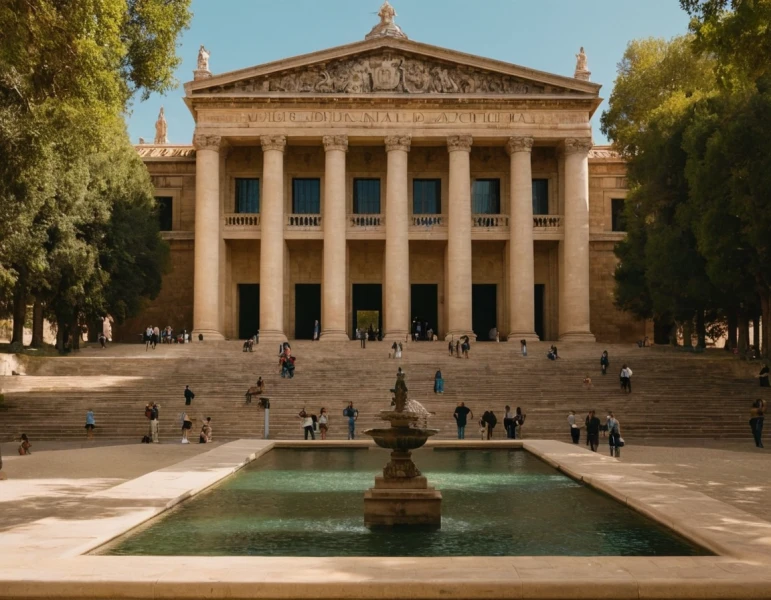Educa UNIVERSITY|ART AND ARCHITECTURE
Museu Nacional d'Art de Catalunya (MNAC): A Personal Journey through Art History
Related Masters
Museu Nacional d'Art de Catalunya (MNAC): A Personal Journey through Art History
Ah, the Museu Nacional d'Art de Catalunya! When I was a kid, I never thought that this majestic place located in the heart of Montjuïc would become one of my favorite corners of the world. In fact, when I was forced to go for the first time, at the age of ten, all I wanted to do was run off to the nearby Barça stadium... but alas, how things have changed!
Over the years, the MNAC has taught me much more than art. It has shown me the evolution of human creativity, the way history, politics and culture are reflected in every brushstroke. And, above all, it has helped me understand that art is not something static, it is a conversation that takes place between generations.
A Palace Made Museum
This impressive museum is located in the Palau Nacional de Montjuïc, an architectural jewel built in 1929 for the Barcelona International Exposition. You know, those events they used to hold to show the world how advanced your country was? This palace was no exception, with a mix of styles that makes you feel like you're walking through the pages of an architectural history book. From Renaissance elements to Baroque details, the building is itself a work of art.

In 1934, the palace became a museum, starting with an impressive collection of medieval art. But it wasn't until the 1990s, when the institution changed its name to Museu Nacional d'Art de Catalunya and expanded, that it reached the size and relevance it has today.
The Collection: A Feast for the Senses
From my first visit, what impressed me most was the Romanesque art collection. The MNAC houses one of the best collections in the world in this style, and believe me, even if you're not a fan of religious art, it's impossible not to be fascinated by the medieval frescoes that cover entire walls of its rooms. Many of these works were brought from Pyrenean churches to be preserved in the museum, making them living testimonies of Catalan history.
In addition to Romanesque art, the MNAC also has extensive collections of Gothic, Renaissance and Baroque art. In my case, one of my favorite artists is El Greco, whose style seems so modern and out of his time that it always leaves me wondering. How could someone from the 16th century paint something so... contemporary?
But, make no mistake! The MNAC is not just for lovers of the past. Since the renovation of its spaces, the museum has expanded its offerings with art from the nineteenth and twentieth centuries, including some of the best pieces of Catalan modernism. If names like Gaudí or Ramon Casas ring a bell, this is the place where you can really appreciate the impact these artists had on modern art.
My Favorite Memories
Every time I return to MNAC, it's like reconnecting with an old friend. One of my most vivid memories was a temporary exhibition on Pablo Picasso. Although many people associate Picasso with the Picasso Museum in Barcelona, the MNAC has housed some of his earliest and most experimental works in its permanent collection and in temporary exhibitions.
Another unforgettable moment was when, on a visit with some friends, we participated in one of the guided tours. We didn't plan it, but suddenly found ourselves learning fascinating details about some pieces that we would never have appreciated on our own. So my advice is this: if you go, join a guided tour. There's always something you'll miss, and the guides at MNAC are true experts in their field.
A Place for Everyone
What I love about MNAC is that it's not just a place for academics or art lovers. This is a space that has adapted to modern audiences, with activities for all ages. From family workshops to programs for adults, MNAC makes sure that every visitor takes away something valuable.
I remember taking my niece to one of their children's workshops. I thought she would be bored, but she ended up delighted with an activity where children recreated some of the most famous works with plasticine. A real success! This shows that the museum is serious about its mission to make art accessible to everyone, regardless of age or background.
The Importance of MNAC in Catalan Culture
The MNAC is not just a museum; it is a symbol of Catalan identity. Within its walls are not only works of art, but also the history and spirit of a people who have known how to preserve their legacy despite political and social challenges. It is a constant reminder of the importance of art in the construction of identity.
That is why, every time I walk through its galleries, I feel a deep connection with Barcelona and with Catalonia. This place is a reflection of the soul of the region, a space where the ancient and the modern coexist harmoniously, and where human creativity in all its forms is celebrated.
Tips for your Visit
If you plan to visit the MNAC, here are some insider tips. First, I recommend going early to avoid the crowds, especially on weekends. Also, don't miss the terrace of the palace, which offers one of the best panoramic views of Barcelona. And if you go during the summer months, be sure to take advantage of the light show that's projected onto the museum's facade at sunset. It's absolutely magical.
Finally, don't forget that the museum offers discounts and free admission on some days of the month, so check the calendar on its website before planning your visit.
Faculties
Trainings
The faculties embrace diverse academic disciplines and fields of study, opening doors to new perspectives and exploring different spheres of wisdom in a constantly evolving world.














